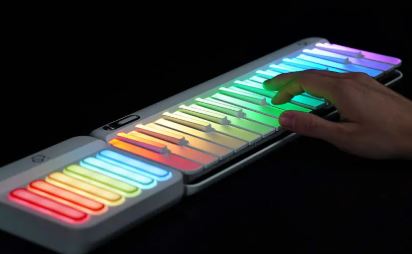
Starting piano is exciting—until you have to choose between a 61 key keyboard vs 88 key instrument. Do you go compact and affordable, or full-size for the most authentic experience? This guide breaks down the real-world differences so you can buy with confidence.
We’ll compare size, touch, repertoire, price, learning features, and portability. You’ll also get a simple decision framework and a first-month practice plan that works for either layout.
|
Factor |
61 Key Keyboard |
88 Key Keyboard |
|
Size / Weight |
Compact, light, easy to store; dorm- and desk-friendly |
Full length, heavier; best in a fixed spot |
|
Key Feel |
Often unweighted or semi-weighted; easier for small hands |
Typically fully weighted; closer to acoustic piano |
|
Repertoire |
Great for pop, beginners, left-hand basics; some pieces need octave shifts |
Full classical/jazz repertoire without compromises |
|
Learning Curve |
Lower effort to start; often includes light guidance + app drills |
More realistic technique development from day one |
|
Portability |
High (backpack/case, battery options) |
Low (home/studio only) |
|
Price |
Generally more affordable |
Higher cost for quality actions |
|
Connectivity |
Frequently Bluetooth/USB-MIDI for apps/DAWs |
Varies; many support USB-MIDI, some add Bluetooth |

A 61 key model is shorter and slimmer, often light enough to move between rooms or bring to class. If your “music corner” is a small desk or a shelf, 61 makes daily practice easier. An 88 key instrument gives you the full acoustic layout, but you’ll likely set it in a permanent spot.
Rule of thumb: if you can’t leave it out, you won’t practice as often. For many beginners, smaller wins.
The biggest keyboard vs digital piano difference is action. Many 61s ship with unweighted or semi-weighted actions, which feel light and forgiving. That’s good for beginners and younger players. Most 88 key instruments aim to mimic acoustic hammer action, building finger strength and control you’ll need for advanced pieces.
If you’re curious about technique but not ready to commit, start on a light action and add weighted feel later—or choose a model that can expand keys and difficulty gradually.
A lot of pop, film themes, worship, and entry-level classical can be learned on 61 keys with octave shift buttons when needed. However, intermediate classical and jazz standards assume 88 keys. If you dream of Chopin, 88 is the eventual destination. If your goal is to play songs you love and accompany vocals, 61 is more than enough to start.
Modern 61 key keyboards often lean into interactive learning: light-up keys, guided songs, short app drills, and progress tracking. That’s a real advantage for motivation during the first month. Many 88 key boards focus on feel and tone over flashy features, though some still connect to apps.
If you’re new, a guided start matters more than anything. It’s easier to upgrade range later than to restart a habit you never built.

The Dorm Room Starter
The Returning Adult
The Future Classical Player
The Parent + Child Duo
The Creator/Producer

In the first 60–90 days, your progress comes from consistency, not key count. Five focused sessions a week beat a big keyboard you rarely touch. That’s why many beginners choose 61 key keyboard vs 88 key at first—because a smaller instrument fits daily life.
Cost: 61-key models are generally cheaper, especially if you want extras (bag, stand, headphones). Quality 88 key instruments cost more due to keybed engineering and cabinetry.
Space: If it can’t live where you practice, you’ll fall off. Tape out the footprint on your desk or stand before you buy.
Portability: For lessons, jams, or travel, a compact board wins. If you’re setting up a permanent corner at home, 88’s footprint is fine.
Week 1: Make Sound, Not Excuses
Week 2: Rhythm & Confidence
Week 3: Expand Skills
Week 4: Share & Review
Yes—for pop, basics, and early classical. Many pieces fit fine with occasional octave shifts. As you advance, certain repertoire benefits from 88.
Not if you practice regularly with good fingering and rhythm. Weighted 88 helps technique, but consistency matters more for beginners.
Sustain helps make music feel musical. Some 61s support a pedal; many 88s include or support one. Add it when you start combining hands.
Most modern boards support USB-MIDI and many offer Bluetooth. Look for simple pairing and low latency.
Prioritize light guidance, short lessons, and fun songs. A compact board encourages daily play. Upgrade when attention and hands are ready.
If your top priority is starting today—with short, motivating sessions—go with a 61 key keyboard vs 88 key full-size board. You’ll practice more because it fits your life. Choose a model that pairs cleanly with learning apps and, if possible, offers an upgrade/expansion path so you don’t outgrow it in six months.
If you already know you want the full acoustic experience, weighted action, and classical depth, go 88 keys and set up a reliable practice corner at home.
When you want a compact, app-friendly instrument that can grow with you, explore a smart portable option with an expansion route:
Read more

What’s the Difference Between a Digital Keyboard and a Digital Piano?
If you’re shopping for your first instrument, you’ve likely run into two common terms: digital piano and portable keyboard. They may look similar, but the difference between a keyboard and a piano ...

5 Best Keyboards with Lighted Keys for Beginners
If you’re starting from zero and want to play real songs fast, a keyboard with lighted keys for beginners is the easiest on-ramp. Guided LEDs show which note to hit next, and most modern models pai...